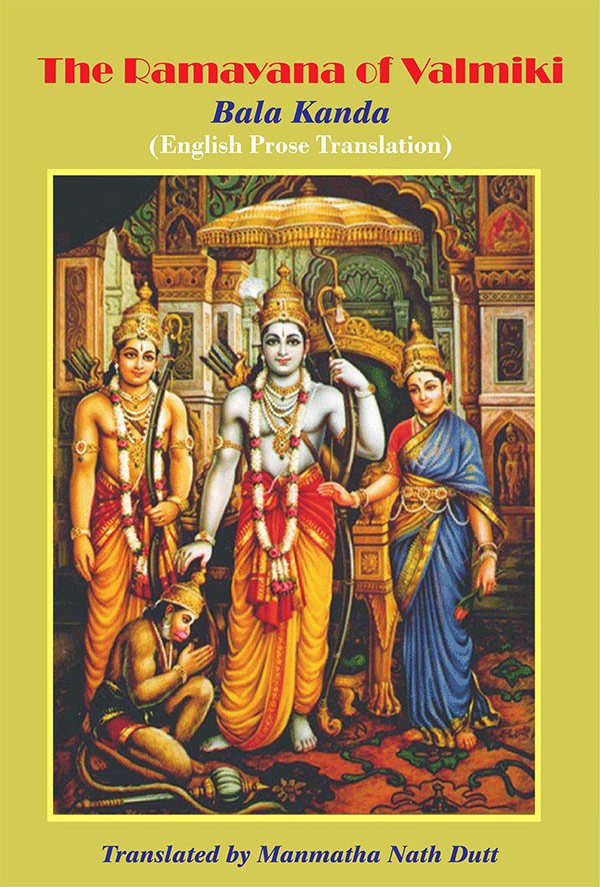Ramayana of Valmiki
by Hari Prasad Shastri | 1952 | 527,382 words | ISBN-10: 9333119590 | ISBN-13: 9789333119597
This page is entitled “the story of the king of himalayas’ younger daughter uma” and represents Chapter 36 of the Bala-kanda of the Ramayana (English translation by Hari Prasad Shastri). The Ramayana narrates the legend of Rama and Sita and her abduction by Ravana, the king of Lanka. It contains 24,000 verses divided into seven sections [viz., Bala-kanda].
Chapter 36 - The story of the king of Himalayas’ younger daughter Uma
Hearing the wonderful narrative, so eloquently related by Shri Vishvamitra, both the princes praised the holy sage and said: “O Divine Sage, you have told us a tale, by the hearing of which great merit is acquired, be gracious enough to enlighten us further regarding the elder daughter of the King of Himalaya. You are omniscient, therefore describe to us fully, how the Gunga, the world purifying stream, came down from heaven to earth. O You, versed in the science of dharma, why is this sacred river called Tripathaga (the Traverser of the Three Worlds) and whence is this name derived?”
Seated amidst the other sages, Shri Vishvamitra, whose only wealth was truth and austerity, spoke as follows, in answer to Shri Rama’s questioning:—
“O Prince, in ancient times, the holy Lord Mahadeva was wedded to Parvati and being charmed with her beauty devoted himself to the delights of connubial bliss. According to the measure of time of the gods, the Lord Mahadeva passed a hundred years with that devi but remained without issue.
In their anxiety, the gods approached Shri Brahma and said:—
“‘Who will be able to endure the power and glory of the offspring produced by these two mighty beings?’
“They then took refuge with Shri Mahadeva, saying:
‘O God of Gods, O Mahadeva, ever engaged in doing good to all beings, we offer salutations to you, be gracious unto us! Your power, O First among the Gods, none can endure, therefore with this goddess engage in yogic penances. For the welfare of the three worlds, retain thine energy within your body so that the universe may be preserved and may not suffer destruction’.”
The Ruler of the World, Shri Mahadeva, listened to the words of the devas and said: “Be it so, O Devas, I will restrain my power so that all the regions including the earth may dwell in peace, but O Devas, should my vital fluid overflow, who shall receive it?”
The gods answered Shri Mahadeva, saying: “Let the earth receive it.”
Then Shri Mahadeva let fall his seed on the earth covering the mountains, seas and forests. When the earth could bear no more, the devas asked the wind and fire deities to combine with that creative power and thus was a white mountain created and later a heavenly forest as resplendent as the light of the sun. From this fiery light was born the glorious Swami Karttikeya.
“All the gods and rishis were full of joy and adored the Lord Shiva and the goddess Uma. As they worshipped them with grateful hearts, Uma was filled with wrath and said:
‘O Devas, your action has filled me with displeasure, you shall not escape the consequences.’
“Then Uma shining like the sun, took water in the palm of her hand and pronounced a curse on the gods, saying:
‘O Devas, you have prevented me from bearing a son, may you be childless from this day, may your wives be without progeny.’
“Still not appeased, Uma cursed the earth also and said:
‘O Earth, you shalt never remain in one form, you shalt have many masters. O Witless One, you shalt never bear a son, since you have prevented me from becoming a mother.’
“Shri Mahadeva, seeing the devas discomfited, prepared to depart to the northern region of the Himalayas. There, on a peak named Himavatprabhava, he engaged in prolonged yogic practices together with Uma.
“O Rama, I have told you of one of the two daughters of the Himalayas; now with Lakshmana, listen to the tale of the other daughter of Himalaya, named Gunga.”
